

|
| DEUTSCHLAND | GERMANY |
| Bundesland: Nordrhein-Westfalen | North Rhine-Westphalia |
| Regierungsbezirk: Düsseldorf | |
| Stadt: Düsseldorf |
Düsseldorf is situated at an elevation of 38 m on the right bank of the Rhine river at the mouth of the river Düssel. Only the quarters Oberkassel, Niederkassel, Heerdt and Lörick are located on the left bank of the Rhine. Düsseldorf is the capital of Germany's state of Nordrhein-Westfalen and is the seat of the administrative region Düsseldorf. The city, which is administered as a district in its own right, has a population of about 573,600 (2005).
The earliest written mention of Dusseldorp is found in a document of 1135. In 1288 it was chartered as a town by Count Adolf V of Berg. The dukes of Berg chose Düsseldorf as their residence in 1385. The last duke of Jülich, Kleve and Berg from the house von der Mark died without heir in 1609. It took until 1614 that the Treaty of Xanten in 1614 stipulated that the duchy of Jülich and Berg with Düsseldorf was given to the house of Pfalz-Neuburg. Under Electors Palatine Johann Wilhelm and Karl Theodor Düsseldorf became a formidable residence town. In 1795 the town was occupied by French troops and remained under French rule until 1801. According to the Peace of Lunéville Düsseldorf became part of Bavaria, but already in 1806 it became the capital of the Grand Duchy of Berg. Together with Berg, Düsseldorf became part of Prussia after the Congress of Vienna (1815). After World War I, Düsseldorf was occupied by France between 1921 and 1925. The town was severely hit during World War II. In 1946, Düsseldorf became the capital of the new state of Nordrhein-Westfalen.

The picture on glass no. 1412 [left] shows the
 Königsallee.
Königsallee.
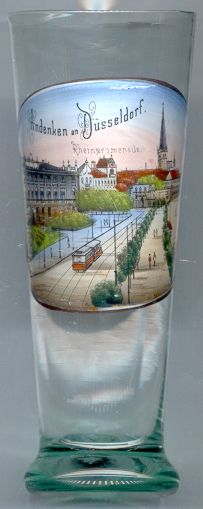
The picture on glass no. 1413 [near left] shows the
 Rheinpromenade.
Rheinpromenade.
The history of the
(see also list of other basilicae minores depicted on glasses of this collection)
The
Several glasses of this collection show other monuments for Wilhelm I.
The extensive (612.000 m²) park is divided into the French Garden, east of the castle, and the English Garden, commonly called
The  church of Sankt Lambertus [left, no. 1413: background right]
presumably goes back to a church that was first mentioned in 1159. After 1288 the church was enlarged in Gothic style.
The choir was added, the nave was lengthened by one case bay and the construction of the spire was taken up.
After 1380 the Romanesque nave was demolished and replaced by a Gothic nave with added side aisles. The new church was
consecrated in 1394 and was dedicated to the Virgin Mary, St. Lambertus, Apollinaris, Thomas and Pankratius.
The relics of St. Appolinaris of Ravenna, the patron saint of Düsseldorf, were brought to the city in 1383 and are kept in a
precious shrine of 1699. The Gothic interior decorations were mostly destroyed by a fire in 1634 and were replaced
by Baroque decorations. The roof of the spire had to be replaced in 1815. However, the wood that was used for the new roof
was not dry enough so that the roof gradually took on a twisted shape. In this peculiar form the spire became a beloved
landmark of Düsseldorf. The church obtained the papal title Basilica minor in 1974.
church of Sankt Lambertus [left, no. 1413: background right]
presumably goes back to a church that was first mentioned in 1159. After 1288 the church was enlarged in Gothic style.
The choir was added, the nave was lengthened by one case bay and the construction of the spire was taken up.
After 1380 the Romanesque nave was demolished and replaced by a Gothic nave with added side aisles. The new church was
consecrated in 1394 and was dedicated to the Virgin Mary, St. Lambertus, Apollinaris, Thomas and Pankratius.
The relics of St. Appolinaris of Ravenna, the patron saint of Düsseldorf, were brought to the city in 1383 and are kept in a
precious shrine of 1699. The Gothic interior decorations were mostly destroyed by a fire in 1634 and were replaced
by Baroque decorations. The roof of the spire had to be replaced in 1815. However, the wood that was used for the new roof
was not dry enough so that the roof gradually took on a twisted shape. In this peculiar form the spire became a beloved
landmark of Düsseldorf. The church obtained the papal title Basilica minor in 1974.
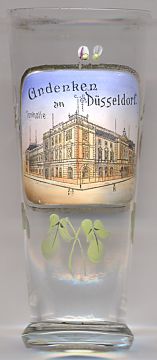
Glass no. 2212 near left shows a view of the old
 Tonhalle
Tonhalle
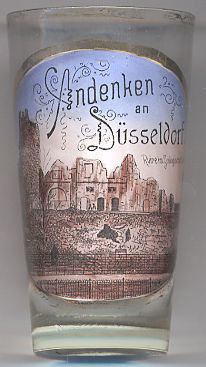
Glass no. 2439 [left, no. 2439] shows a view of the  Ruins in the Zoological Garden.
The idea for a zoo was brought up by the well-known zoologist and writer Alfred Brehm who had been a frequent guest of the Fauna Society of Düsseldorf.
The zoological garden was laid out in an area which at that time was situated at the city's perimeter and today is in the
city quarter of Düsseltal. The ceremonial opening took place on the 31st of May, 1876. Part of the grounds of the zoo was a flamingo pond
and the artificial ruins of an old castle. During World War II the zoo was completely destroyed by an allied bomb raid in 1943.
Parts of the collection could be saved and became the basis for the Löbbecke-Museum which was opened in 1947 in a former
air-raid shelter. The museum was expanded by an aquarium in 1948. In 1987 the zoo moved to the Nordpark and reopened under the
new name Aquazoo-Löbbecke-Museum. The grounds of the original zoo were redeveloped in 1951 into a public park (Zoopark).
Ruins in the Zoological Garden.
The idea for a zoo was brought up by the well-known zoologist and writer Alfred Brehm who had been a frequent guest of the Fauna Society of Düsseldorf.
The zoological garden was laid out in an area which at that time was situated at the city's perimeter and today is in the
city quarter of Düsseltal. The ceremonial opening took place on the 31st of May, 1876. Part of the grounds of the zoo was a flamingo pond
and the artificial ruins of an old castle. During World War II the zoo was completely destroyed by an allied bomb raid in 1943.
Parts of the collection could be saved and became the basis for the Löbbecke-Museum which was opened in 1947 in a former
air-raid shelter. The museum was expanded by an aquarium in 1948. In 1987 the zoo moved to the Nordpark and reopened under the
new name Aquazoo-Löbbecke-Museum. The grounds of the original zoo were redeveloped in 1951 into a public park (Zoopark).
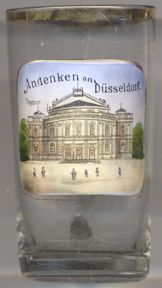
The  Stadttheater Düsseldorf (Municipal Theatre) [near left, no. 4571]
was built in 1873–1875 by the architect Ernst Giese in Renaissance revival style. On the site before the construction of the current theatre was the
Altes Theater ('Old Theatre'). The old theatre house was used as a theatre as early as 1747. After Düsseldorf became Prussian, the old theatre had been
donated to the city of Düsseldorf in 1818. The new municipal theatre was partially destroyed by the air raids on Düsseldorf in World War II,
but was provisionally rebuilt during the war. In 1946, the state parliament of the newly founded state of North Rhine-Westphalia was able to use the opera
house as a meeting place. A comprehensive conversion to the Düsseldorf Opera House of the Deutsche Oper am Rhein was carried out according to plans by
Paul Bonatz, Julius Schulte-Frohlinde and Ernst Huhn from 1954 to 1956, which, however, also included the replacement of all historic façades by
a modern design.
Stadttheater Düsseldorf (Municipal Theatre) [near left, no. 4571]
was built in 1873–1875 by the architect Ernst Giese in Renaissance revival style. On the site before the construction of the current theatre was the
Altes Theater ('Old Theatre'). The old theatre house was used as a theatre as early as 1747. After Düsseldorf became Prussian, the old theatre had been
donated to the city of Düsseldorf in 1818. The new municipal theatre was partially destroyed by the air raids on Düsseldorf in World War II,
but was provisionally rebuilt during the war. In 1946, the state parliament of the newly founded state of North Rhine-Westphalia was able to use the opera
house as a meeting place. A comprehensive conversion to the Düsseldorf Opera House of the Deutsche Oper am Rhein was carried out according to plans by
Paul Bonatz, Julius Schulte-Frohlinde and Ernst Huhn from 1954 to 1956, which, however, also included the replacement of all historic façades by
a modern design.
[https://en.wikipedia.org/wiki/Stadttheater_D%C3%BCsseldorf]
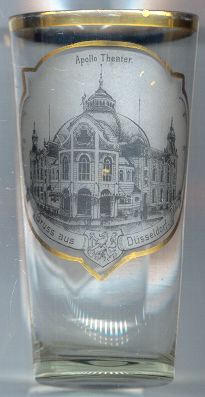
The  Apollo-Theater [near left, no. 1385] was built in 1898–1899 by Hermann vom Endt
as a private theatre at the site of the demolished "Bergisch-Märkischer Bahnhof" and "Köln-Mindener Bahnhof" train stations.
The theatre had 3000 seats and was equipped with all functionalities of the contemporary variety stage, including a floodalbe
water bassin beyond the stalls. It was also used for theatre, opera and operetta performances, and as a cinema. Between 1921
and 1925 it was home to the municipal theatre company. A new façade was added during major rebuilding works in the
1930's. From 1937 it was used as a cinema by the UFA circuit. During World War II the roof was destroyed by bombs in
1942. The theatre re-opened in 1950 and was later used for pop concerts, carnival balls, and congresses. After its closure
in 1959 it was used as a TV studio before it was finally demolished in 1966.
Apollo-Theater [near left, no. 1385] was built in 1898–1899 by Hermann vom Endt
as a private theatre at the site of the demolished "Bergisch-Märkischer Bahnhof" and "Köln-Mindener Bahnhof" train stations.
The theatre had 3000 seats and was equipped with all functionalities of the contemporary variety stage, including a floodalbe
water bassin beyond the stalls. It was also used for theatre, opera and operetta performances, and as a cinema. Between 1921
and 1925 it was home to the municipal theatre company. A new façade was added during major rebuilding works in the
1930's. From 1937 it was used as a cinema by the UFA circuit. During World War II the roof was destroyed by bombs in
1942. The theatre re-opened in 1950 and was later used for pop concerts, carnival balls, and congresses. After its closure
in 1959 it was used as a TV studio before it was finally demolished in 1966.
[Text adapted from http://www.andreas-praefcke.de/carthalia/]
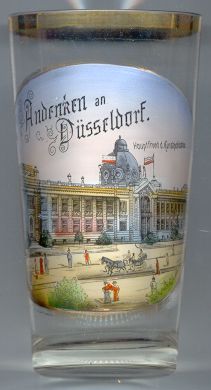
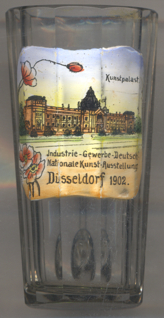
The  Kunstpalast [left, no. 1586, and right, no. 3552]
is the oldest exhibition building of Düsseldorf.
It was built in 1902 according to a design based on that of the Petit Palais in Paris.
From the 1960's until 1976 the structure was used by the trade show corporation Novea.
At that time the structure was already in a somewhat ramshackle condition. Although the Kunstmuseum next door was renovated
in 1985, it took until 2001 that the Kunstpalast also was remodeled. (Glass. no. 3552 [right] is labeled
as a souvenir from the industrial exhibition of 1902 (Düsseldorfer Industrie-, Gewerbe- und Kunst-Ausstellung 1902).
Kunstpalast [left, no. 1586, and right, no. 3552]
is the oldest exhibition building of Düsseldorf.
It was built in 1902 according to a design based on that of the Petit Palais in Paris.
From the 1960's until 1976 the structure was used by the trade show corporation Novea.
At that time the structure was already in a somewhat ramshackle condition. Although the Kunstmuseum next door was renovated
in 1985, it took until 2001 that the Kunstpalast also was remodeled. (Glass. no. 3552 [right] is labeled
as a souvenir from the industrial exhibition of 1902 (Düsseldorfer Industrie-, Gewerbe- und Kunst-Ausstellung 1902).
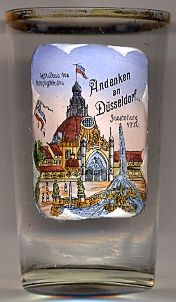
The picture on glass no. 2543 [near left] shows the
 main
main
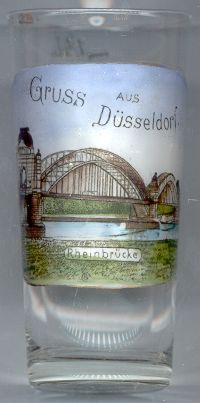
The  Rhine Bridge between Düsseldorf and Oberkassel [left] was built in
1898. The steel arch bridge was the first firm bridge across the Rhine at Düsseldorf and had a total length of 638 m
with two main spans of 181.25 m each. The bridge was destroyed in 1945.
A new steel bridge (Oberkasseler Brücke) was constructed in 1926.
Rhine Bridge between Düsseldorf and Oberkassel [left] was built in
1898. The steel arch bridge was the first firm bridge across the Rhine at Düsseldorf and had a total length of 638 m
with two main spans of 181.25 m each. The bridge was destroyed in 1945.
A new steel bridge (Oberkasseler Brücke) was constructed in 1926.
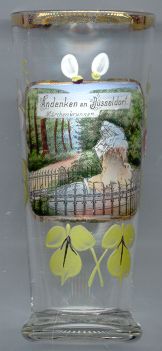
 Märchenbrunnen ('fairy tale fountain') [right] in Hofgarten was created by the French sculptor
Max Blondat. A design model had already been presented at the Paris Art Salon of 1904 before the
fountain was displayed in Düsseldorf at the International Horticultural Exhibition of the same year. It was admired by
so many visitors that the Leipziger Kunstverein (Leipzig Art Association), the director of the Palmengarten at
Frankfurt and the "Verschönerungsverein für die Stadt Düsseldorf" (Association for the Embellishment
of the City of Düsseldorf) competed for its acquisition. Düsseldorf was successful and the fountain was unveiled at its
new location at the Ananasberg in Hofgarten in November 1905.
Märchenbrunnen ('fairy tale fountain') [right] in Hofgarten was created by the French sculptor
Max Blondat. A design model had already been presented at the Paris Art Salon of 1904 before the
fountain was displayed in Düsseldorf at the International Horticultural Exhibition of the same year. It was admired by
so many visitors that the Leipziger Kunstverein (Leipzig Art Association), the director of the Palmengarten at
Frankfurt and the "Verschönerungsverein für die Stadt Düsseldorf" (Association for the Embellishment
of the City of Düsseldorf) competed for its acquisition. Düsseldorf was successful and the fountain was unveiled at its
new location at the Ananasberg in Hofgarten in November 1905.
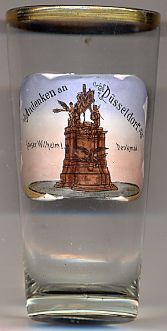
The  monument for Emperor Wilhelm I [right] was erected in
Martin-Luther-Platz in 1896. The bronze monument on a granite pedestal was created by Karl Jansen.
monument for Emperor Wilhelm I [right] was erected in
Martin-Luther-Platz in 1896. The bronze monument on a granite pedestal was created by Karl Jansen.
Benrath
[http://en.wikipedia.org/wiki/Düsseldorf-Benrath, http://en.wikipedia.org/wiki/Düsseldorf]

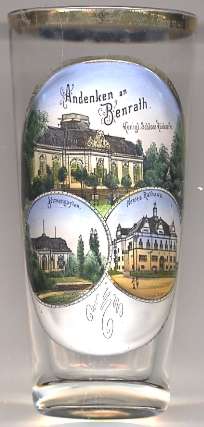
 Schloss Benrath (Benrath Caste) [left, no. 2774, and right, no. 2971: top picture]
was erected for the Elector Palatine Karl Theodor by his garden and building director and garden supervisor, Nicolas de Pigage. It was begun in 1755,
and by the time it was completed in 1770, some elements of Neoclassicism were detectable in its interior finishing. Two symmetrical wings flank the central corps de logis.
The ensemble at Benrath has been proposed for designation as a UNESCO World Heritage Site. Karl Theodor never actually lived in Benrath. After inheriting the
Electorate of Bavaria, he movd his residence to Munich in 1777. During the Napoleonic times, between 1806 and 1813, Benrath Castle was the
official residence of the Grand Dukes of Berg (Joachim Murat, Napoléon Louis and Emperor Napoléon I). After the Congress of Vienna in 1815
the castle came in possession of Prussia. King Friedrich Wilhelm III placed it at the disosal of his nephew Friedrich Wilhelm Ludwig of Prussia. After 1852
the castle was used by Prince Karl Anton of Hohenzollern-Sigmaringen who had addicated in his principality in favour
of Prussia. In 1862 Wilhelm I of Prussia placed the castle at the disposal of Hereditary Prince Leopold of Hohenzollern-Sigmaringen. The castle had to be renovated
thoroughly and the works were only completed in 1870. The princely family lived in the castle until 1875. In 1911 the municipality of Benrath acquired the castle
from the Prussian state. Since the incorporation of Benrath into Düsseldorf in 1929 the castle is a property of the city of Düsseldorf. Castle and park were put
under monumental protection in 1984.
Schloss Benrath (Benrath Caste) [left, no. 2774, and right, no. 2971: top picture]
was erected for the Elector Palatine Karl Theodor by his garden and building director and garden supervisor, Nicolas de Pigage. It was begun in 1755,
and by the time it was completed in 1770, some elements of Neoclassicism were detectable in its interior finishing. Two symmetrical wings flank the central corps de logis.
The ensemble at Benrath has been proposed for designation as a UNESCO World Heritage Site. Karl Theodor never actually lived in Benrath. After inheriting the
Electorate of Bavaria, he movd his residence to Munich in 1777. During the Napoleonic times, between 1806 and 1813, Benrath Castle was the
official residence of the Grand Dukes of Berg (Joachim Murat, Napoléon Louis and Emperor Napoléon I). After the Congress of Vienna in 1815
the castle came in possession of Prussia. King Friedrich Wilhelm III placed it at the disosal of his nephew Friedrich Wilhelm Ludwig of Prussia. After 1852
the castle was used by Prince Karl Anton of Hohenzollern-Sigmaringen who had addicated in his principality in favour
of Prussia. In 1862 Wilhelm I of Prussia placed the castle at the disposal of Hereditary Prince Leopold of Hohenzollern-Sigmaringen. The castle had to be renovated
thoroughly and the works were only completed in 1870. The princely family lived in the castle until 1875. In 1911 the municipality of Benrath acquired the castle
from the Prussian state. Since the incorporation of Benrath into Düsseldorf in 1929 the castle is a property of the city of Düsseldorf. Castle and park were put
under monumental protection in 1984.
[https://de.wikipedia.org/wiki/Schloss_Benrath, http://en.wikipedia.org/wiki/Schloss_Benrath]
 Blumengarten
Blumengarten
[https://de.wikipedia.org/wiki/Schloss_Benrath, http://en.wikipedia.org/wiki/Schloss_Benrath]
 new town hall of Benrath [left, no. 2774, and right, no. 2971: bottom right picture] was built in 1906
in Weser-Renaissance revival style. At the time Benrth was an independent municipality but did not have the rights of a town. Being already an important
industrial community, the new town hall was supposed to underpin the claims for the town rights. In 1929 Groß-Benrath (Benrath, Hassels, Himmelgeist, Holthausen, Itter,
Niederheid, Oberheid, Paulsmühle, Reisholz, Rittersberg and Urdenbach) was incorporated into the city of Düsseldorf, despite protests by many of the
inhbitants of Benrath. In order to appease the community, the new city district was granted several special prerogatives, of which some still apply today.
new town hall of Benrath [left, no. 2774, and right, no. 2971: bottom right picture] was built in 1906
in Weser-Renaissance revival style. At the time Benrth was an independent municipality but did not have the rights of a town. Being already an important
industrial community, the new town hall was supposed to underpin the claims for the town rights. In 1929 Groß-Benrath (Benrath, Hassels, Himmelgeist, Holthausen, Itter,
Niederheid, Oberheid, Paulsmühle, Reisholz, Rittersberg and Urdenbach) was incorporated into the city of Düsseldorf, despite protests by many of the
inhbitants of Benrath. In order to appease the community, the new city district was granted several special prerogatives, of which some still apply today.
![[scale]](lineal.jpg)